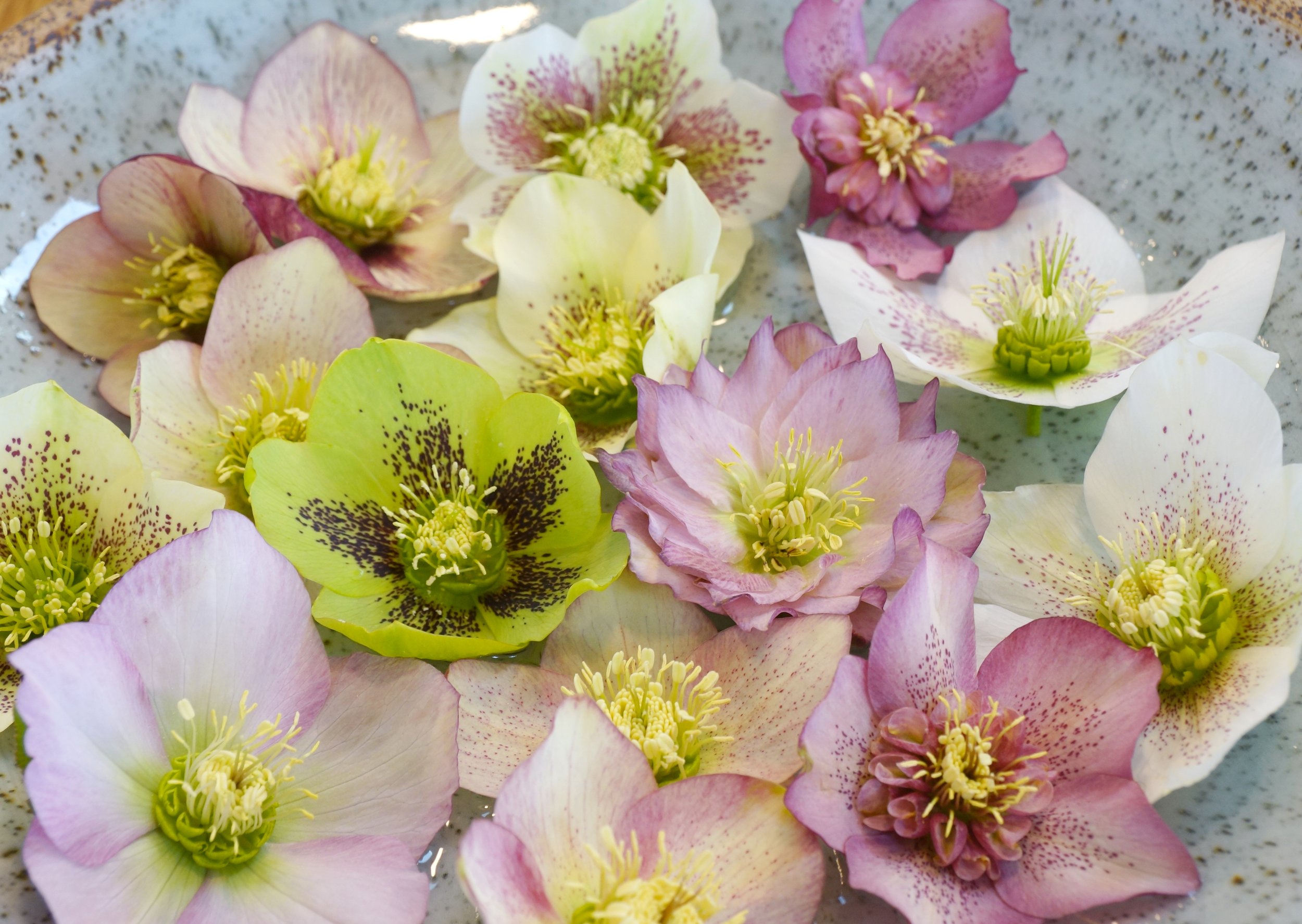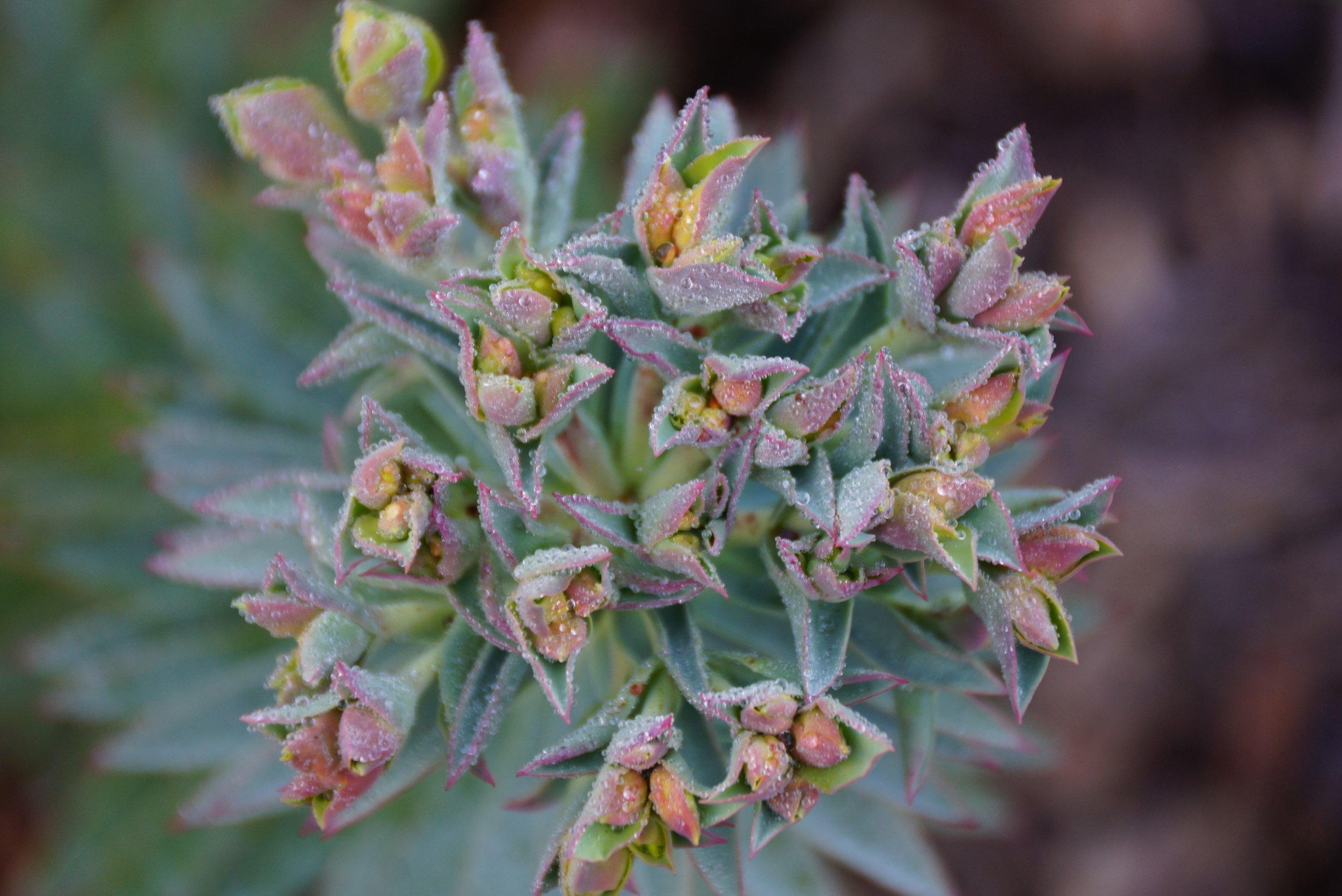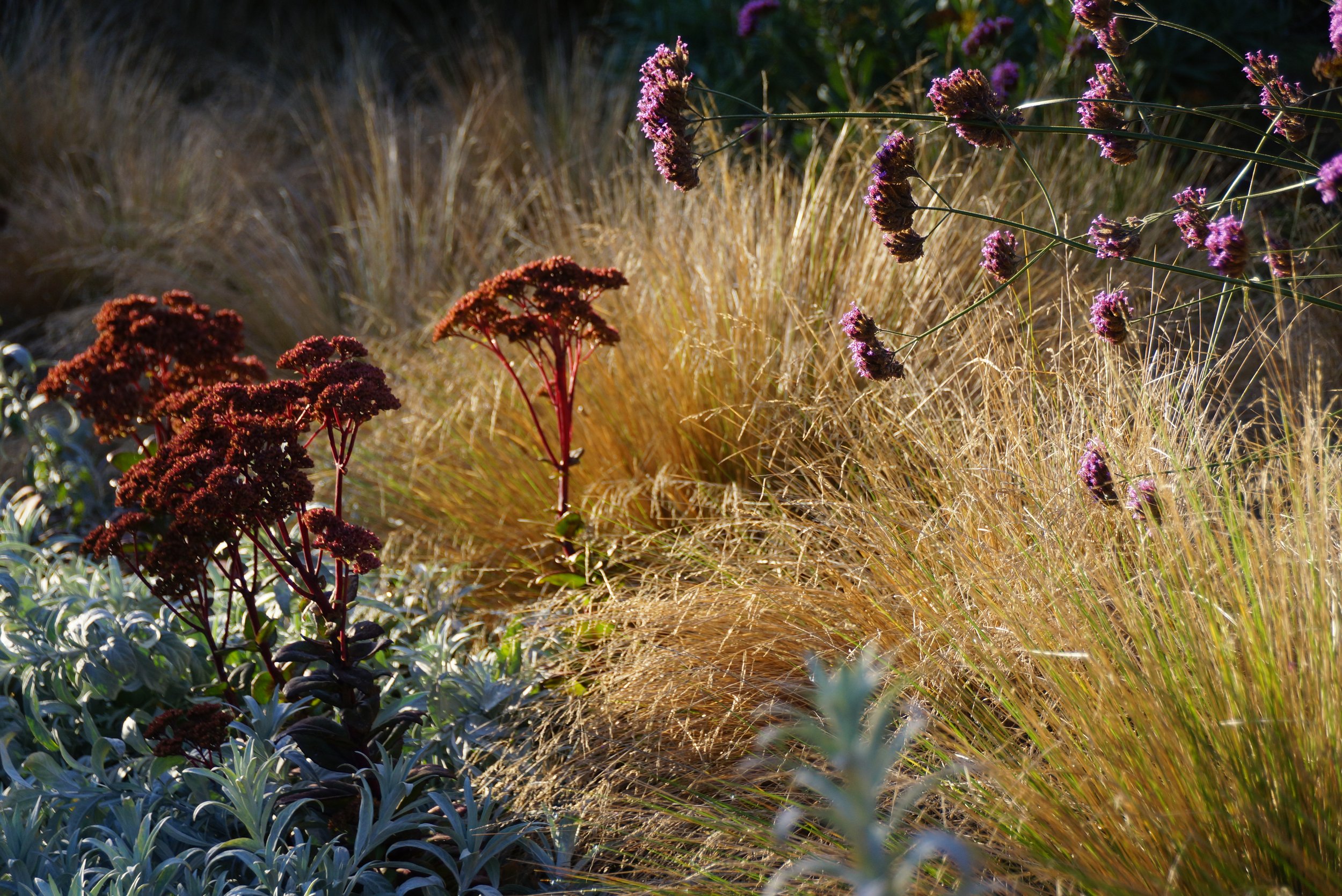DON’T MENTION THE WORD BRUNCH
After weeks and weeks of nothing much happening in the garden, except for mud, puddles, and depressed looking sparrows, suddenly spring has arrived with a flourish. Everywhere I turn, tiny green points are appearing…. on the twigs of the trees, and little green noses peeping out from the mulch. Outside by 8 am in dressing gown, head down, bum up, I can easily spend an hour peering at these tiny miracles.
Don’t invite me to weekend brunch! What a waste of a beautiful spring day, I will have brunch in summer when the heat means gardening ceases. All the avocado smash in town would not tempt me away from the first furry shoots of pulsatilla or the first golden cowslip.
It is the woodland garden that calls to me at this time of year. The spring bulbs and shade-loving plants are beginning their race to complete their life cycle before the tree canopy closes overhead. The perennial and gravel gardens have all year to carry out their more flashy, sun-baked life cycles and are not in such a rush. That is a joy yet to come.
Spring for us begins with the first snowdrops, then suddenly the bluebells are here, arriving seemingly overnight. The hellebores are at their fresh and sweet best, nodding away in the cool dawn, and I can see the tiny bent necks of the woodland anemone rising up ready to take their place.
Words and imagery by Jenny Cooper.
“I find myself looking at these plants 3 or 4 times a day, during tea breaks from work, that extend to whole hours outside. I can’t seem to help myself - this is absolutely my happy place, bent over, cup of tea in one hand, elbow on knee, just watching the plants, or bending up the faces of the hellebores to say hello. It has been a year since I saw you last, old friend!”
The neat green rosettes of violets, pulmonaria and saxifrage are as exciting to see as the first time I planted them, 50 years ago. Each plant is an old friend, plus there are new plants to look forward to.
This year I am growing my first ever zinnia, my first Pennisetum villosum (thank you Julia, but it has disappeared underground, should I be worried?), and first deschampsia -an unknown variety as the seed was ‘rescued’ in autumn from the fabulous Trott’s Garden in Ashburton. And this year I have my first, and very precious Euphorbia rigida, a gift from a friend, almost impossible to obtain, and just about to flower.
Above and below - Euphorbia rigida
I find myself looking at these plants 3 or 4 times a day, during tea breaks from work, that extend to whole hours outside. I can’t seem to help myself - this is absolutely my happy place, bent over, cup of tea in one hand, elbow on knee, just watching the plants, or bending up the faces of the hellebores to say hello. It has been a year since I saw you last, old friend!
This happy gardener was made even happier by the arrival of a huge truckload of fresh ramial woodchip, delivered free by Elite Trees. Thank you guys!
Ramial wood chip is the whole living tree mulched up and can be put on the garden while fresh. Mulching is a must to stop weeds from germinating in this huge garden. With the threat of an El Niño summer ahead, an unmulched bed makes me feel uncomfortable, like having scalded skin, it seems sore and vulnerable. Once the garden is tucked up under its thick blanket, I can step back and let the plants do their thing for the rest of the year, with the soil protected from UV rays and the drying nor ’wester.
A pile of ramial woodchip ready for dispersion.
So the winter upheaval continues apace, especially in the huge grass border. This bed runs right through the middle of our 4600 m2 and is seen from both sides, so doesn’t have the luxury of a wall or hedge to anchor it. Originally I wasn’t clear in my head about what I was trying to achieve. So it became a grab bag of plant shapes and colours, but didn’t satisfy. At all times of year the sun shines directly through it, as we see it from the house. So I’m making its central position a feature: this bed should be about transparency, light and movement.
I am trying to remove what doesn’t work, and repeat what does, and in the process simplify and strengthen the design. To begin with, I removed all the hebe and shrubby salvia. Their forms were stiff and fussy, and did not work well with the diaphanous grasses and upright perennials. Also, truth to tell, I am a little bored with the shrubby salvias (Salvia greggii). They are just soooo tough and reliable, but form slightly dull blobs.
Chris then gave me half a day, digging out and dividing the massive miscanthus grasses. At maybe 6 years old, they were getting very bulky and needed to be split before they were too big for us to handle.
Miscanthus gracillimus seedheads
They were chopped up with an axe and cumbersome root balls were rolled into the back of a friend’s car to be redistributed to gardens north of here…. Thank you Penny for taking those monsters off my hands, and I do apologise for all the dirt and mess in your car, especially the rear car door side pockets! Eeek.
The miscanthus - I am using less of. I loved it standing tall in the middle of the grass border, but it was casting too much shade, A bed you can see from two sides has its own dilemmas, inevitably it develops a front (in the sun) and a back ( in the shade). I have a huge clump of Dierama pulcherrimum on the shady side, and this plant can’t readily be shifted but hasn’t flowered for 4 years. The Penstemon ‘Purple Passion’ were reaching out to the light and flopping on their neighbours.
Miscanthus in winter - pre the cut back and removal of some
The grass border pre cut back.
Post cut back and removal of grasses - not mulch or replanting yet but you can see how much more sunlight floods in.
By bringing down the height of the grasses, as well as removing some huge euphorbia and griselinia, hopefully both sides of the bed will be flooded with light and flower successfully. And happily, even when I remove these large grasses, they continue to help the garden.
A cespitose grass (all the grasses mentioned above) is a clumping grass, not a running grass. They typically have 2/3 of their organic matter in the soil, as roots. That is a huge amount, when you consider how big these grasses are. And every year, 2/3 of those roots die, and are replaced with fresh roots. That is a massive amount of organic matter being created in my soil, available to all the surrounding plants.
When I dig them out, I leave as much root in the soil as I can, undug. The anemanthele especially can be virtually skimmed off the top of the soil, taking only an inch of root ball. All this lovely organic matter will rot down and feed the next generation of plants. If you are growing grasses, you are in fact growing soil.
I frequently have garden visitors tell me that they hate grasses, most often when we are standing looking at the grass border! I always think, how rude, and also, what a missed opportunity. Grasses in the right spot are the most elegant, yet resilient of plants. Their overall form is bold, but each part is entirely delicate and fine. They love the wind and they shimmer in the sunlight and rain. They have a calming presence and are a wonderful matrix plant between other louder plants. People will lavish time and money on their roses, and persist in doing this despite disease, nude branches, and poor flowering, never admitting how ugly the roses are for much of the year. Yet many people resent having to spend an hour a year looking after a grass. But grasses ask for little and deliver much. A cut back once a year, or grooming with hand or rake. Many are happy in lean soil, and form wonderful mass plantings in difficult areas
Poa cita and sedum in the driest part of the garden.
“Grasses in the right spot are the most elegant, yet resilient of plants. Their overall form is bold, but each part is entirely delicate and fine. They love the wind and they shimmer in the sunlight and rain. They have a calming presence and are a wonderful matrix plant between other louder plants. ”
Poa cita and sedum
And this is the key to successful use of grasses. In the right spot, they are incredibly resilient and beautiful. But many of them are adapted to quite specific conditions. A sun lover will not adapt to shade, a dry lover will flop in moist soil, and a rounded form will be awkward and annoying in a close planting - the failure is often ours, for wishful thinking. This is a group of plants where experimentation really pays off.
Many grasses do best in very lean soil. If you give them rich soil they are huge, floppy and short-lived. This includes most native grasses, as well as, for example, calamagrostis and Helictotrichon sempervirens Blue Oat Grass.
Some grasses (again, most of our native grasses) form naturally beautiful rounded forms, and need some space to express themselves. They also, naturally, create mats of dead grass at their base. This is their way of reducing competition and storing water and nutrients. I have found that these varieties: red tussock, Poa cita, many carex and amenanthele, don’t work well in mixed plantings, but look better with more room to spread their beautiful arching arms.
But I could not do without Poa cita for a hot dry spot, or the elegance of red tussock Chionochloa rubra, which is self-cleaning and oh so stylish and bold if you can give it a little water at the height of summer. Similarly, Anemanthele lessoniana is a wonderful colourful grass if you can give it either water or shade. It is naturally a forest edge grass, and very valuable for being shade tolerant. In full sun it can appear burnt and be a bit stubby.
The softeness of Anemanthele lessoniana (NZ wind grass) in flower.
“Some grasses (again, most of our native grasses) form naturally beautiful rounded forms, and need some space to express themselves. They also, naturally, create mats of dead grass at their base. This is their way of reducing competition and storing water and nutrients. ”
Another shade-loving grass is the altogether fabulous hakonechloa, a plant I cannot get enough of. It has everything I love in a grass; beautiful arching form, slowly spreading but not seeding, autumn colour, drought and flood tolerant, calm and elegant.
The more upright Northern Hemisphere grasses such as miscanthus, and Calamagrostis ‘Karl Foerster and ‘Overdam’, work well with perennials, and give a more ‘meadow’ and a less ’tussock’ vibe. They are the perfect anchors for the large grass border, along with Pennisetum villosum and Stipa gigantea, a lower grasses but with striking inflorescences. All these Northern Hemisphere grasses are deciduous, so can be cut back at the same time as the perennials, which reduces their bulk and freshens them in spring.
After my huge re-jig, I do hope my grasses have found their places at last. The bed is looking a little gap-toothed, but now I have a new garden to fill up around the grasses, with lovely clean soil, and heaps of sunlight flooding in. The really fun part begins now as I go through the nursery to find perennials to work with the grasses.
No brunch invitations please, this gardener is busy.
Mooschi looking less than enthusiastic about spring!
Provided links to plants are chosen by Julia with no bias - simply to connect with the best imagery and information to aid the reader on that plant.
Not affiliate or sponsored links are included - please beware they may contain some seasonal information from other countries that differ from the one you are in!


















